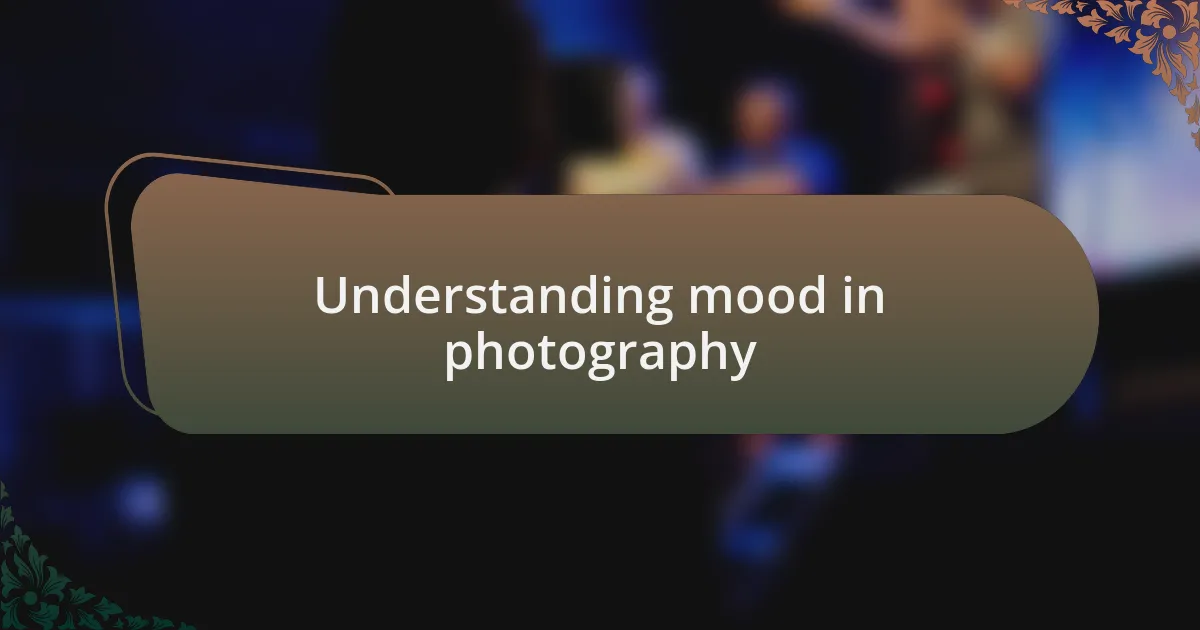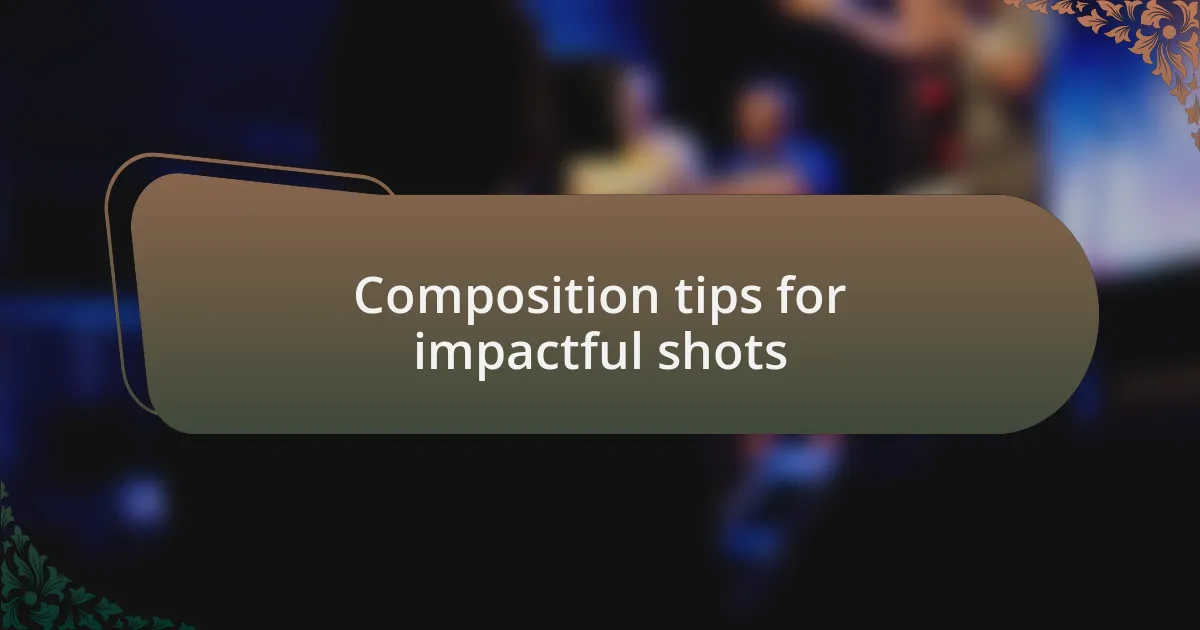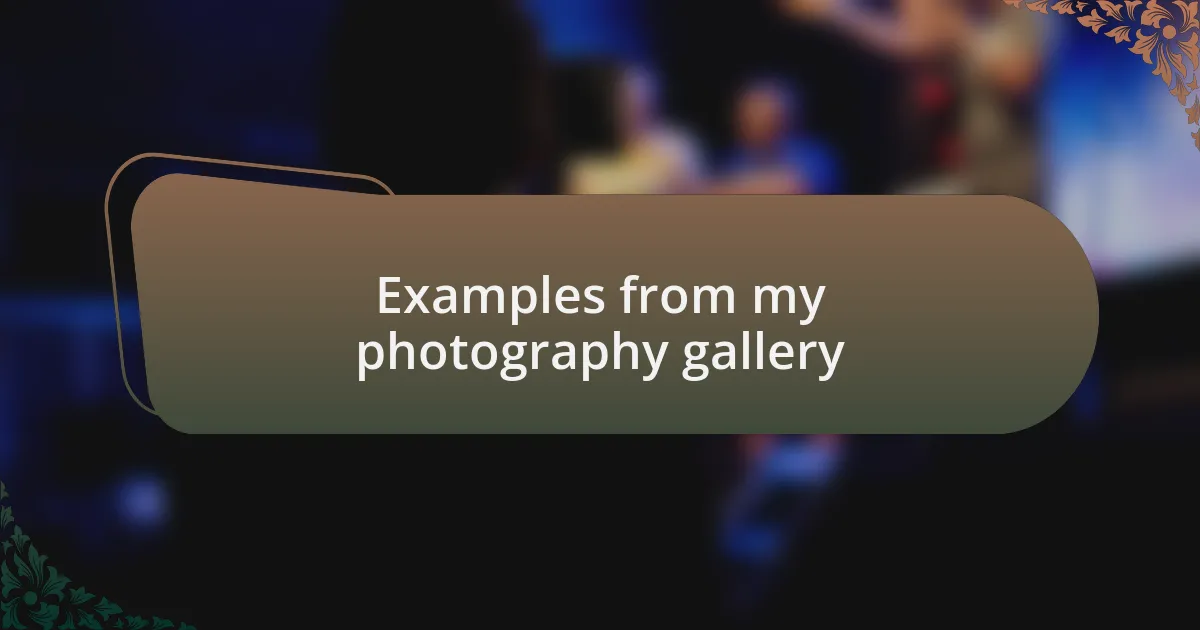Key takeaways:
- Mood in photography is shaped by light, shadow, and composition, influencing viewer emotions and story perception.
- Techniques for creating mood include careful lighting choices, isolating subjects through composition, and emphasizing textures.
- Effective composition strategies like the rule of thirds and leading lines can enhance visual storytelling and viewer engagement.
- Editing plays a crucial role in achieving the desired mood, with adjustments to exposure, contrast, and additional details like grain impacting emotional responses.

Understanding mood in photography
Creating mood in photography is an intricate dance between light, shadow, and composition. I remember one foggy morning when I ventured out with my camera, the mist enveloping everything in a soft blanket. This ethereal atmosphere instantly conjured a sense of mystery and tranquility in my black and white shots, proving how ambient conditions can radically shape the feelings captured in an image.
Mood, in essence, is the emotional undercurrent of a photograph. How often do you find yourself gazing at an image and feeling a rush of nostalgia or unease? I’ve experienced this firsthand with high-contrast images that evoke stark emotions. By manipulating brightness and shadow, I can steer the viewer’s reaction, emphasizing what I want them to feel at that moment.
Every photograph tells a story, and the mood is at its core. I think back to a portrait I took of an elderly man sitting alone on a park bench. The thoughtful expression on his face, softened by dim lighting, created a profound sense of solitude. It’s moments like these that remind me of the power of mood in photography, making each image not just a moment captured, but a feeling shared.

Techniques for creating mood
Capturing mood in black and white photography often starts with choosing the right lighting. I recall a day spent in an old, abandoned factory where the shafts of light broke through the dusty windows. The interplay of light and shadow transformed the stark environment into something almost haunting, creating an atmosphere that stirred deep emotions within me. Can you imagine how the same scene might feel completely different in color?
Another technique I find effective is playing with composition. While shooting a crowded street scene, I often isolate a subject to draw attention to their expression or action. I remember once focusing on a lone woman reading on a park bench, all else blurred into the background. This intentional framing not only enhanced the mood of solitude but also invited viewers to share in her moment of introspection. Isn’t it fascinating how a simple shift in perspective can alter our emotional takeaway from an image?
Finally, I never underestimate the power of texture in black and white photography. In fact, I often highlight textures to add depth to my images. During a recent shoot, I captured the weathered surface of an old door, its cracked paint speaking volumes about a forgotten past. The raw, tactile quality of the shot transformed it into a story of time and wear, evoking feelings of nostalgia in anyone who viewed it. How do you think a textured image can speak to emotions differently than a smooth, polished one?

Composition tips for impactful shots
When composing a shot, one effective approach is to utilize the rule of thirds. By positioning your main subject off-center, I’ve observed that it creates a more dynamic image. For instance, during a recent urban walk, I framed a street musician slightly to the right, allowing the surrounding architecture to lead the viewer’s eye. This composition not only added interest but also conveyed the hustle of city life surrounding the solitary artist. Have you tried placing your subject in unconventional spots?
Another technique I often employ is leading lines. Whether it’s a winding path or the edges of a building, these elements can guide the viewer’s gaze toward the focal point. Recently, I captured a bridge that perfectly framed a distant mountain range. The lines drew my eyes directly to the peaks, enhancing the sense of depth in the shot. Can you see how such guidance can provoke anticipation in your audience, pulling them deeper into the narrative of the photo?
Lastly, I find that simplicity can wield tremendous power in composition. When I photographed an elderly man sitting alone at a café, I chose to focus solely on him against a blurred background. This minimalistic approach made his expression stand out, inviting viewers to ponder his thoughts and life story. How does stripping away distractions impact your engagement with a subject? I believe it allows your audience to connect on a more profound emotional level.

My personal editing process
When it comes to my editing process, I usually start with a clear vision of the mood I want to create. For monochrome shots, I often delve into the grayscale sliders first, adjusting exposure and contrast to evoke a specific emotional response. I remember a time when I was editing a series of portraits; I decided to heighten the shadows and soften the highlights, which brought out a deeper, more contemplative atmosphere. How do you find that certain adjustments can transform an image from mundane to meaningful?
After I set the overall tonal adjustments, I shift my focus to fine details, like grain and clarity. It’s fascinating how a subtle addition of grain can lend a nostalgic feel to a photo, reminiscent of film days. I once applied this technique to a desolate street scene, and suddenly, it conveyed a sense of timelessness. Have you ever noticed how texture can shift the narrative of your image completely?
Lastly, the finishing touches are where my creativity truly shines. I enjoy playing with vignettes to subtly draw the viewer toward the center of my composition. In one of my recent edits, I added a soft vignette around a portrait, which separated the subject from a chaotic background. This technique allowed the viewer to focus on the intricate emotions captured in their eyes. What are your go-to methods for emphasizing the subjects in your photos? I’ve found that these small details could make all the difference in storytelling through photography.

Examples from my photography gallery
When I look through my photography gallery, several images stand out, each demonstrating how mood can be captured in monochrome. One particular shot of a foggy landscape illustrates the mystery I often seek; the soft grays and blacks envelop the scene, drawing viewers in with a sense of intrigue. It makes me wonder, have you ever felt that chill of anticipation when gazing at something hazy and unknown?
Another example is a candid street photograph I took during a rainstorm. The glistening pavement and the way shadows danced around the figures added an element of drama that I’d aimed to capture. I remember feeling a rush of excitement as I realized this image conveyed a story of resilience amidst adversity. Can you relate to finding beauty in unexpected weather conditions?
Then there’s the striking portrait of an elderly man, his face etched with lines that tell tales of wisdom. I intentionally used stark contrasts and deep shadows to highlight his gaze, creating an emotional connection with the viewer. It struck me how the light caught the corner of his eye, transforming a simple image into a powerful narrative. Have you experienced that magic when an image suddenly stitches together countless stories?